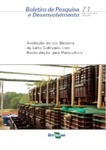Please use this identifier to cite or link to this item:
http://www.infoteca.cnptia.embrapa.br/infoteca/handle/doc/1071110| Title: | Avaliação de um sistema de leito cultivado com recirculação para piscicultura. |
| Authors: | SILVA, M. S. G. M. e  LOSEKANN, M. E.   ROSTON, D. M.   |
| Affiliation: | MARIANA SILVEIRA GUERRA MOURA E SILVA, CNPMA MARCOS ELISEU LOSEKANN, CNPMA DENIS MIGUEL ROSTON, FEAGRI, UNICAMP. |
| Date Issued: | 2017 |
| Citation: | Jaguariúna: Embrapa Meio Ambiente, 2017. |
| Pages: | 27 p. |
| Description: | Resumo: O presente estudo teve como objetivo avaliar a eficiência de leitos cultivados de fluxo subsuperficial no tratamento do efluente de piscicultura da tilápia-do-nilo (Oreochromis niloticus) em escala piloto, com ciclo fechado de água. Para tanto, foi construído um sistema de leitos cultivados composto por três unidades com os seguintes tipos de meio suporte: brita, argila expandida e uma mistura homogênea de ambos os substratos, denominada MIX. Estes meios suportes foram avaliados com e sem a presença da planta vetiver (Chrysopogon zizanioides). A eficiência dos leitos foi medida por avaliações de parâmetros físicoquímicos da água bruta e tratada, além do desempenho da planta vetiver no tratamento da água. Os resultados indicam que o meio suporte composto de brita com vetiver apresentou melhor eficiência como tratamento do efluente de piscicultura considerando a avaliação da qualidade da água, principalmente para os parâmetros: pH (próximo da neutralidade - 6,55), condutividade elétrica (0,49 mS/cm), e nitrogênio total (0,086 mg/L), com maior percentual de redução após o tratamento, onde a brita em associação com o vetiver apresentou redução de 85% do nitrogênio total. Tais resultados reforçam o potencial deste sistema para uso por piscicultores, pois emprega materiais de custo relativamente baixo, porém com elevada eficiência na redução de parâmetros críticos para a piscicultura. Abstract: The present study aimed to evaluate the efficiency of subsurface flow constructed wetlands to treat effluent from fish farming of nile tilapia (Oreochromis niloticus) in pilot scale with closed water cycle. To this end, it set up a system of constructed wetlands consisting of three types of support media: gravel, expanded clay and a homogeneous mixture of both substrates, called MIX. These support media were tested with and without the association with the plant vetiver (Chrysopogon zizanioides). The performance of the beds was measured by assessments of physical-chemical parameters of effluent and treated water, besides the performance of the vetiver plant in water filtration. The results indicate that the gravel bed associated with the plant vetiver performed better for the quality of the treated water for pH (closer to neutrality ? 6,55), electric conductivity (0,49 mS/cm) and total nitrogen (0,086 mg/L) (highest percentage reduction after treatment). The gravel in association with vetiver showed a reduction of 85% of the total nitrogen. These results reinforce the potential of this system for use by fish farmers, since it uses materials of relatively low cost but with high efficiency in the reduction of critical parameters for fish farming. |
| Thesagro: | Piscicultura Oreochromis Niloticus |
| Keywords: | Tratamento de água Sistema de recirculação |
| Series/Report no.: | (Embrapa Meio Ambiente. Boletim de Pesquisa e Desenvolvimento, 71). |
| ISSN: | 1516-4675 |
| Type of Material: | Folhetos |
| Access: | openAccess |
| Appears in Collections: | Boletim de Pesquisa e Desenvolvimento (CNPMA)  |
Files in This Item:
| File | Description | Size | Format | |
|---|---|---|---|---|
| BP71Mariana.pdf | 1,02 MB | Adobe PDF |  View/Open |









